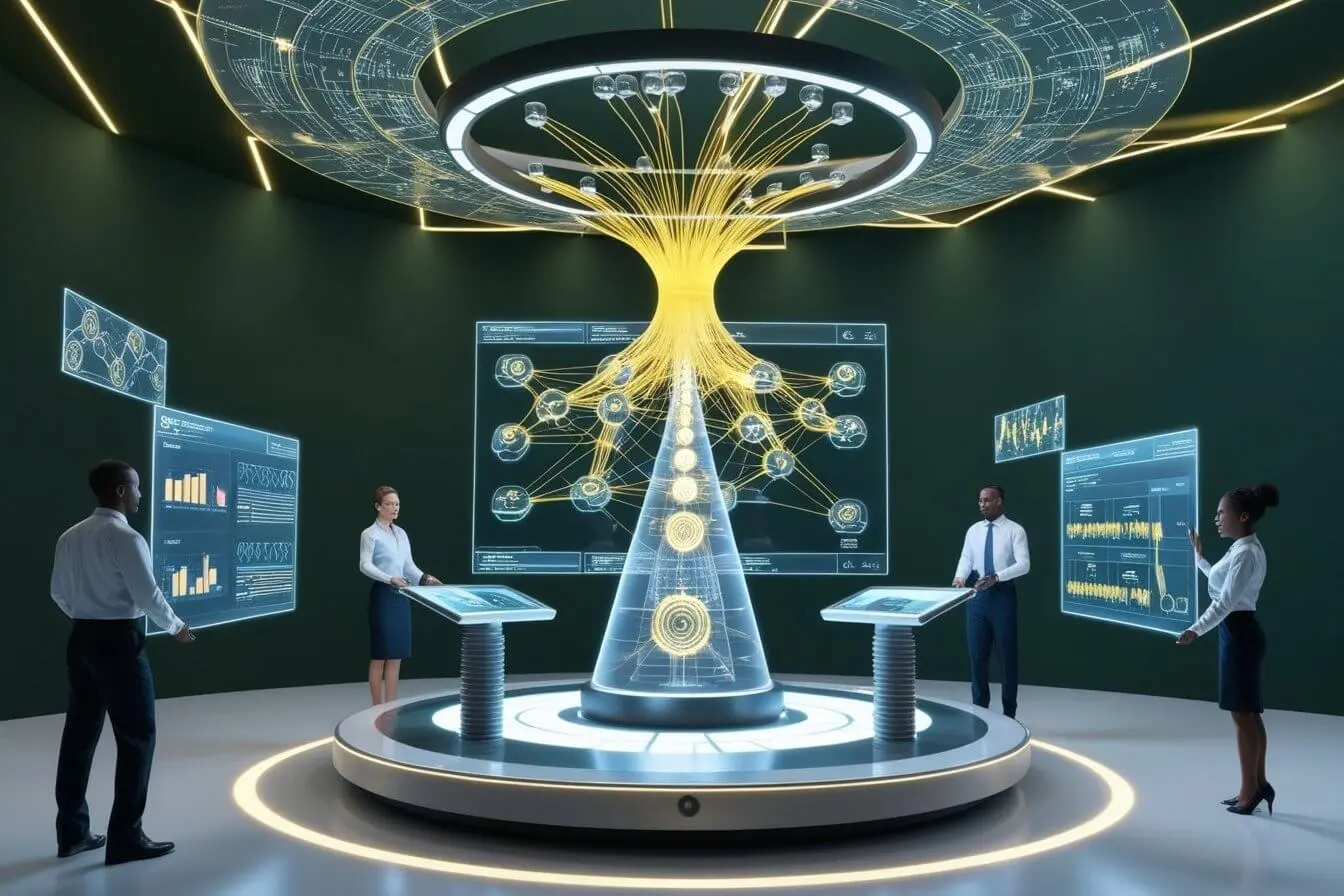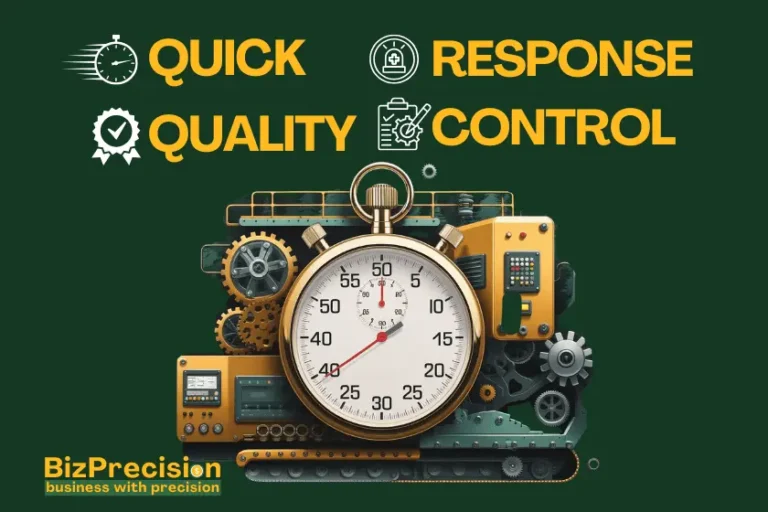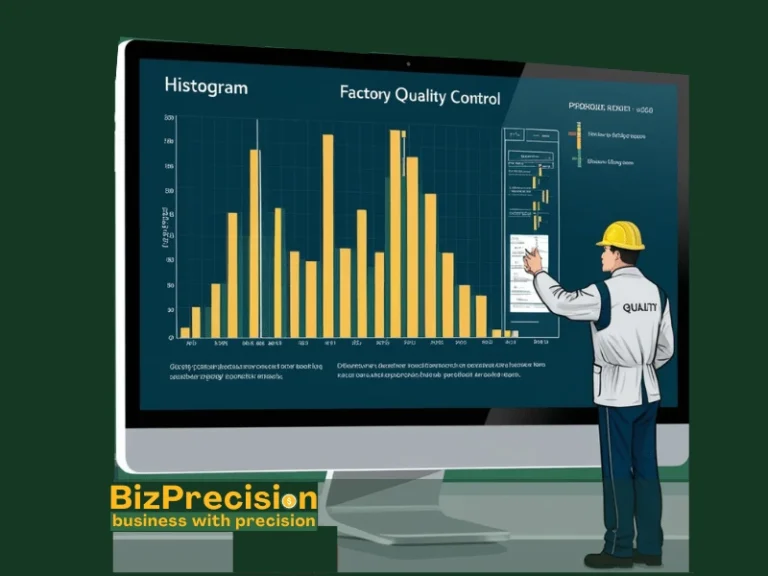What is a Resource Management Office (RMO)?
A Resource Management Office (RMO) is a specialized department that oversees and optimizes an organization’s resource allocation and utilization.
Think of it as your organization’s central hub for making sure every project gets the right people and tools at the right time.
According to a 2023 Project Management Institute study, companies with dedicated RMOs show 25% higher resource efficiency and complete 30% more projects on time. These numbers highlight why more businesses are adding RMOs to their structure.
In today’s fast-paced business world, an RMO helps solve three main challenges:
- Matching available resources with project demands
- Reducing resource conflicts between departments
- Tracking and improving resource usage across the organization
This guide explores how an RMO works, its key benefits, and the steps to set up an effective resource management system in your organization.
What is a Resource Management Office (RMO)?
Definition and Core Functions
A Resource Management Office handles how an organization uses its people, tools, and other resources. Based on a 2023 Gartner report, 65% of large companies now use RMOs to manage their resources better.
The main jobs of an RMO include:
- Planning who works on what projects – This means looking at skills and availability to put the right people on the right tasks.
- Tracking how resources are used – RMOs watch how teams use their time and tools to spot ways to work better.
- Solving resource conflicts – When multiple projects need the same people or tools, the RMO figures out the best solution.
Key Differences Between RMO and PMO
While both offices help manage projects, they serve different purposes:
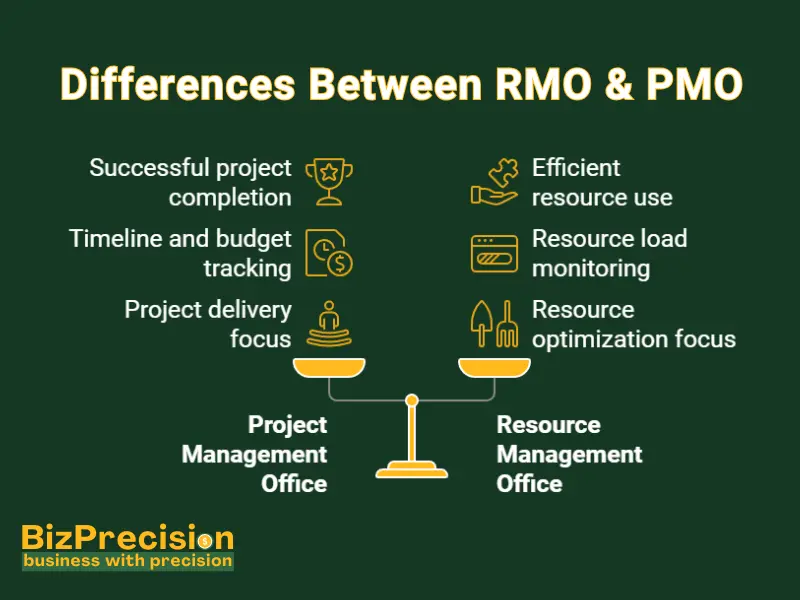
- Focus Areas: PMOs look at project delivery and methods. RMOs zero in on resource use across all projects.
- Daily Tasks: PMOs track project timelines and budgets. RMOs watch resource loads and staff needs.
- Main Goals: PMOs aim for successful project completion. RMOs work to use resources in the best way possible.
Evolution of Resource Management in Modern Organizations
Resource management has changed a lot since 2020. A Harvard Business Review study shows that companies with good resource management are 40% more likely to finish projects on time.
Key changes include:
- Moving from manual to digital tracking
- Using data to predict resource needs
- Adding flexible resource pools
- Focusing more on skills than job titles
Benefits of Establishing an RMO
Setting up an RMO brings clear benefits:
- Better Resource Use: Teams waste less time and money on projects
- Faster Project Delivery: The right resources are ready when needed
- Higher Team Success: People work on tasks that match their skills
- Lower Costs: Better planning means less waste and overtime
5 Core Responsibilities of an RMO
1. Strategic Resource Planning and Allocation
Good resource planning starts with knowing what you have and what you need. A 2023 PMI survey found that projects with proper resource planning are 35% more likely to succeed.
Key planning steps include:
- Making a skills inventory – List all available skills and who has them
- Checking project needs – Figure out what each project requires
- Matching people to projects – Put the right skills with the right tasks
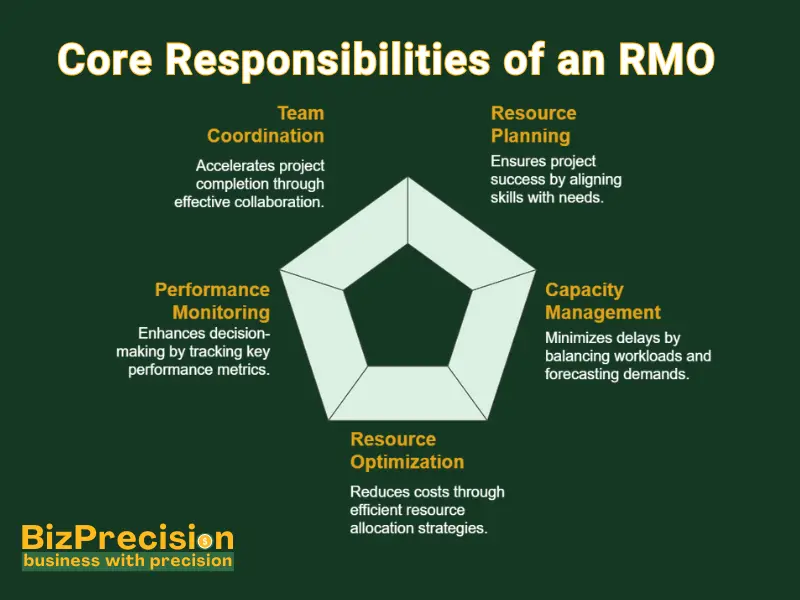
2. Capacity Management and Forecasting
Smart capacity planning helps avoid overwork and project delays. According to Deloitte’s 2023 Project Management Survey, good capacity planning can cut project delays by 40%.
Main tasks involve:
- Tracking current workloads – Know how busy each person and team is
- Predicting future needs – Plan for upcoming project demands
- Spotting capacity gaps – Find where more resources might be needed
3. Resource Optimization Strategies
Making the best use of resources saves time and money. McKinsey reports that good resource optimization can save organizations up to 30% in resource costs.
Key strategies include:
- Using shared resource pools – Share talent across projects
- Cross-training teams – Help people learn new skills
- Setting clear priorities – Know which projects need resources first
4. Performance Monitoring and Analytics
Tracking how well resources are used helps make better decisions. A 2023 PwC study shows that data-driven resource management improves project success rates by 25%.
Important metrics include:
- Resource utilization rates – How much of available time is used
- Project completion rates – How often projects finish on time
- Team productivity levels – How much work teams get done
5. Cross-functional Team Coordination
Good teamwork across departments helps projects succeed. Research from MIT shows that well-coordinated teams finish projects 30% faster.
Key coordination tasks:
- Setting clear roles – Everyone knows their job
- Creating communication plans – Teams know how to share updates
- Managing dependencies – Understanding how teams rely on each other
5 Essential Components of an Effective RMO
1. Resource Management Tools and Software
The right tools make resource management easier. Forrester research shows that good resource management software can improve productivity by 20%.
Must-have features include:
- Resource scheduling – Plan who works when
- Time tracking – Monitor how time is spent
- Skills management – Track team capabilities
- Reporting tools – Show resource use patterns
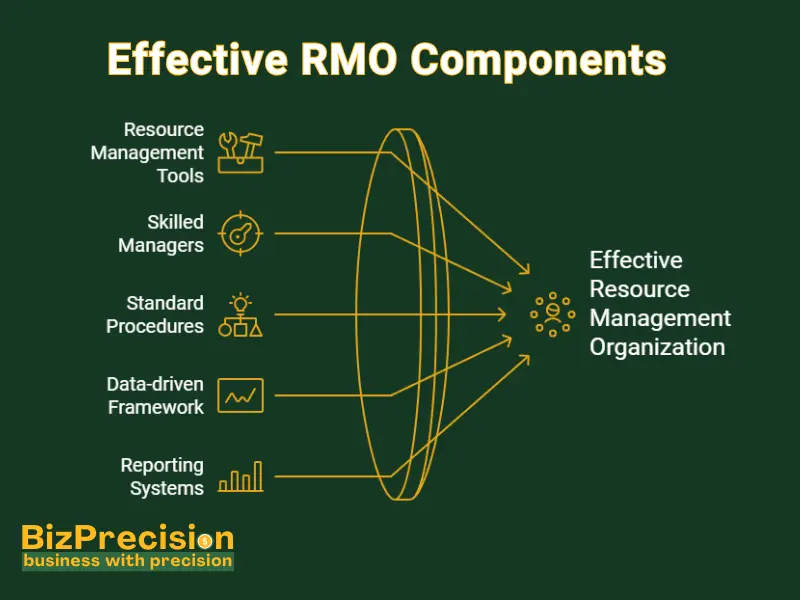
2. Skilled Resource Managers and Analysts
Good people make RMOs work better. According to LinkedIn’s 2023 Workforce Report, skilled resource managers are among the top 10 most in-demand roles.
Key skills needed:
- Project management knowledge – Understanding how projects work
- Data analysis abilities – Making sense of resource data
- People skills – Working well with different teams
- Problem-solving talent – Finding good solutions quickly
3. Standard Operating Procedures
Clear procedures help everyone work the same way. ISO studies show that standard procedures can reduce errors by 45%.
Important procedures include:
- Resource request process – How to ask for resources
- Allocation rules – How resources are assigned
- Conflict resolution steps – How to solve resource conflicts
4. Data-driven Decision-making Framework
Using data helps make better choices. A 2023 IBM study found that data-driven decisions are 60% more likely to be successful.
Key framework elements:
- Data collection methods – Getting the right information
- Analysis techniques – Understanding what the data means
- Decision guidelines – Using data to make choices
5. Reporting and Documentation Systems
Good reporting helps track progress and spot problems. According to PMI, regular reporting can improve project success rates by 28%.
Essential reports include:
- Resource usage reports – Show how resources are used
- Capacity reports – Track available versus used resources
- Performance metrics – Measure how well resources work
RMO’s Impact on Business Operations
Improved Resource Utilization
Better resource use means more gets done. A 2023 KPMG study shows that good resource management can improve productivity by 25%.
Key improvements include:
- Less idle time – Resources stay busy but not overworked
- Better skill matching – Right people on right tasks
- Reduced waste – Resources used more efficiently
Cost Reduction and Control
Good resource management saves money. Deloitte reports that effective RMOs can cut operational costs by 20%.
Ways to save include:
- Less overtime needed – Better planning reduces extra hours
- Lower contractor costs – Better use of internal teams
- Fewer project delays – Right resources ready when needed
Enhanced Project Delivery
Projects finish better with good resource management. PMI data shows that strong RMOs improve project success rates by 35%.
Benefits include:
- More on-time projects – Resources ready when needed
- Better quality work – Right skills for each task
- Happier stakeholders – Projects meet their goals
Better Workforce Planning
Good planning helps keep teams working well. According to Mercer’s 2023 Workforce Survey, strong workforce planning improves employee satisfaction by 40%.
Planning benefits:
- Better hiring decisions – Know what skills you need
- Improved training plans – Develop the right skills
- Lower turnover – Keep people happy and engaged
Risk Management and Mitigation
Managing risks helps avoid problems. Risk management studies show that good planning can reduce project failures by 30%.
Key risk areas:
- Resource shortages – Not having enough people
- Skill gaps – Missing needed expertise
- Resource conflicts – Too many projects needing same resources
Setting Up a Successful RMO
Assessment of Organizational Needs
Know what your organization needs. McKinsey reports that good needs assessment improves RMO success rates by 45%.
Assessment steps:
- Review current processes – See how things work now
- Find pain points – Spot where problems happen
- Set clear goals – Know what you want to achieve
Building the RMO Framework
A good framework helps the RMO succeed. Gartner research shows that well-planned RMOs are 50% more effective.
Framework elements:
- Clear structure – Define how the RMO works
- Set roles – Assign clear responsibilities
- Create processes – Plan how work gets done
Selecting the Right Technology Stack
Good tools help RMOs work better. Forrester shows that the right tech can improve RMO efficiency by 35%.
Key considerations:
- User-friendly systems – Tools people can easily use
- Integration ability – Works with other systems
- Reporting features – Shows needed information
Training and Team Development
Well-trained teams work better. LinkedIn Learning reports that training improves team performance by 40%.
Training needs:
- Tool training – Learn to use RMO systems
- Process training – Understand how things work
- Skill development – Build needed abilities
Implementation Timeline and Milestones
Good planning helps RMOs start right. PMI data shows that clear timelines improve implementation success by 55%.
Timeline elements:
- Clear phases – Break work into steps
- Set deadlines – Know when things should finish
- Track progress – Monitor how things are going
Best Practices in Resource Management
Resource Demand Planning
Plan for what you’ll need. Harvard Business Review shows good demand planning improves resource use by 30%.
Planning steps:
- Forecast needs – Predict future requirements
- Check capacity – Know what you can handle
- Plan ahead – Get ready for future needs
Skills Matrix Development
Know your team’s skills. Deloitte research shows skills matrices improve team performance by 25%.
Matrix elements:
- Current skills – What people know now
- Needed skills – What projects require
- Skill gaps – What training is needed
Resource Conflict Resolution
Solve problems fairly. PMI data shows good conflict resolution improves project success by 40%.
Resolution steps:
- Spot conflicts early – Find problems quickly
- Use clear rules – Know how to decide
- Keep everyone informed – Share decisions made
Capacity vs. Demand Balancing
Keep work and resources matched. KPMG reports good balancing improves productivity by 35%.
Balancing tasks:
- Watch workloads – Monitor how busy teams are
- Adjust as needed – Move resources around
- Plan for changes – Be ready to shift things
Continuous Process Improvement
Keep getting better. ISO studies show regular improvements boost efficiency by 20%.
Improvement areas:
- Get feedback – Listen to teams
- Make changes – Fix what needs fixing
- Track results – See if changes help
Measuring RMO Success
Key Performance Indicators (KPIs)
Track what matters. Gartner shows that tracking the right KPIs improves RMO performance by 45%.
Important KPIs:
- Resource use rates – How well resources are used
- Project success rates – How many projects succeed
- Cost savings – Money saved through better planning
Resource Utilization Metrics
Watch how resources are used. McKinsey reports good tracking improves resource use by 30%.
Key metrics:
- Time tracking – How time is spent
- Skills use – How skills are applied
- Cost per resource – What resources cost
ROI Assessment Methods
Measure value gained. PwC studies show ROI tracking improves resource investments by 40%.
Assessment areas:
- Cost savings – Money saved
- Productivity gains – More work done
- Quality improvements – Better results
Stakeholder Satisfaction Surveys
Check if people are happy. Forrester shows satisfaction tracking improves RMO success by 35%.
Survey topics:
- Resource availability – Getting needed resources
- Process clarity – Understanding how things work
- Support quality – Getting help when needed
Continuous Feedback Loops
Keep improving based on input. MIT research shows feedback improves performance by 25%.
Feedback areas:
- Process feedback – How things work
- Tool feedback – How systems help
- Support feedback – How teams get help
Conclusion
A Resource Management Office plays a key role in modern business success. Based on recent studies, companies with RMOs save 20-30% on resource costs and finish more projects on time.
The main benefits of an RMO include:
- Better use of people and resources
- Lower project costs
- Faster project delivery
- Happier teams
Starting an RMO takes work, but the results are worth it. You’ll need good tools, trained staff, and clear processes. Begin with a simple plan and build from there.
Remember, success comes from tracking the right things and making changes when needed. Your RMO should grow and change with your business needs.

